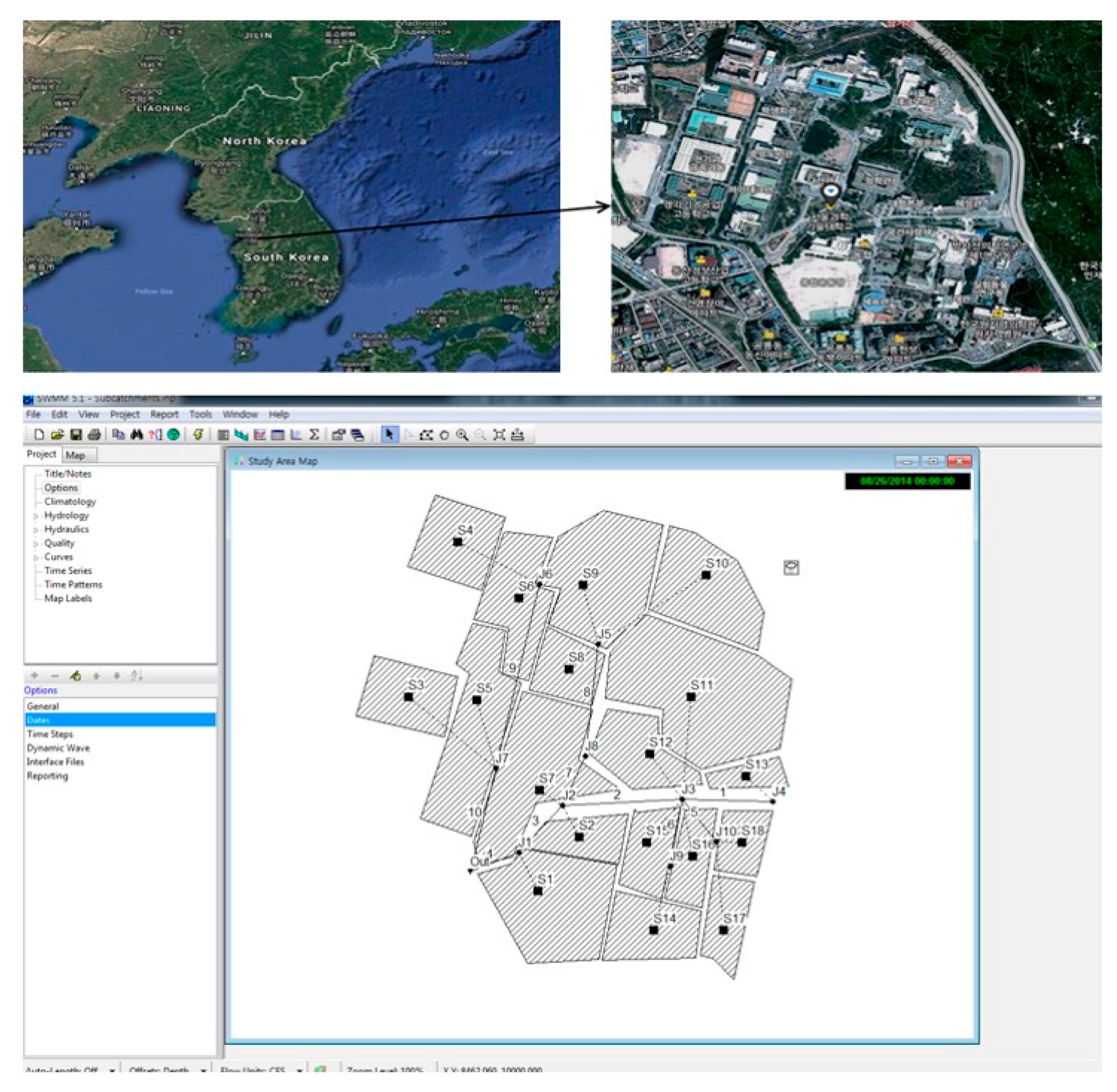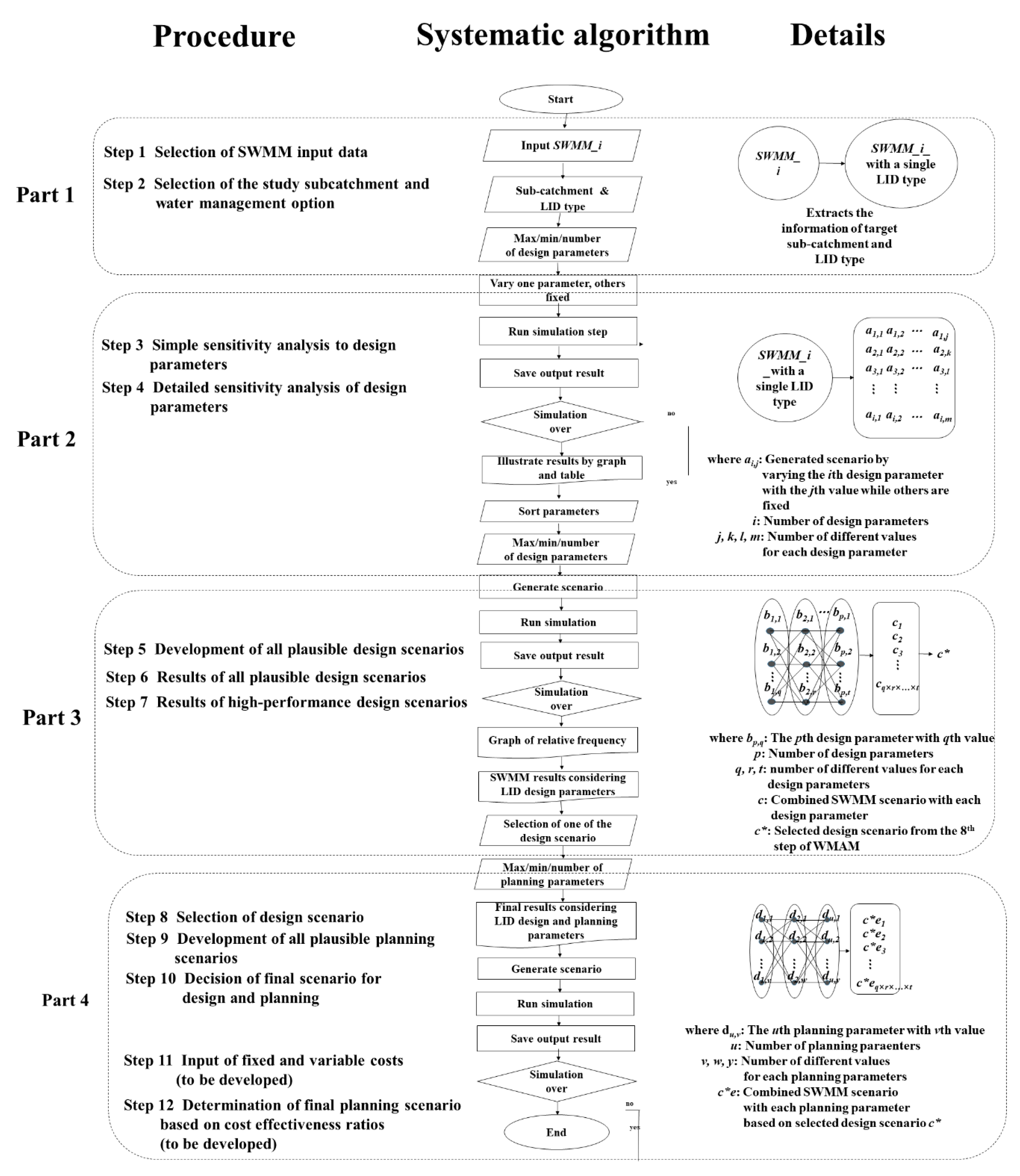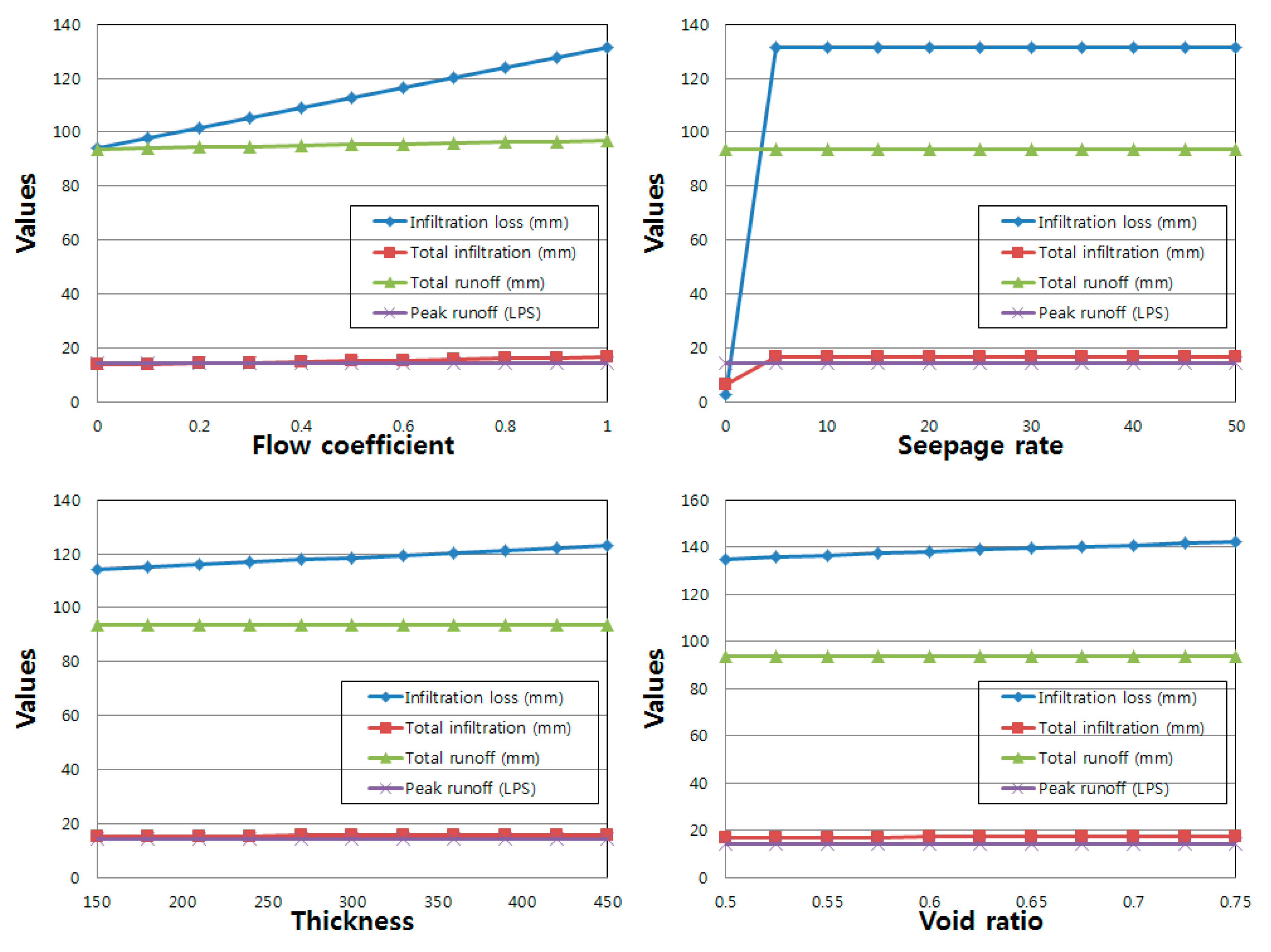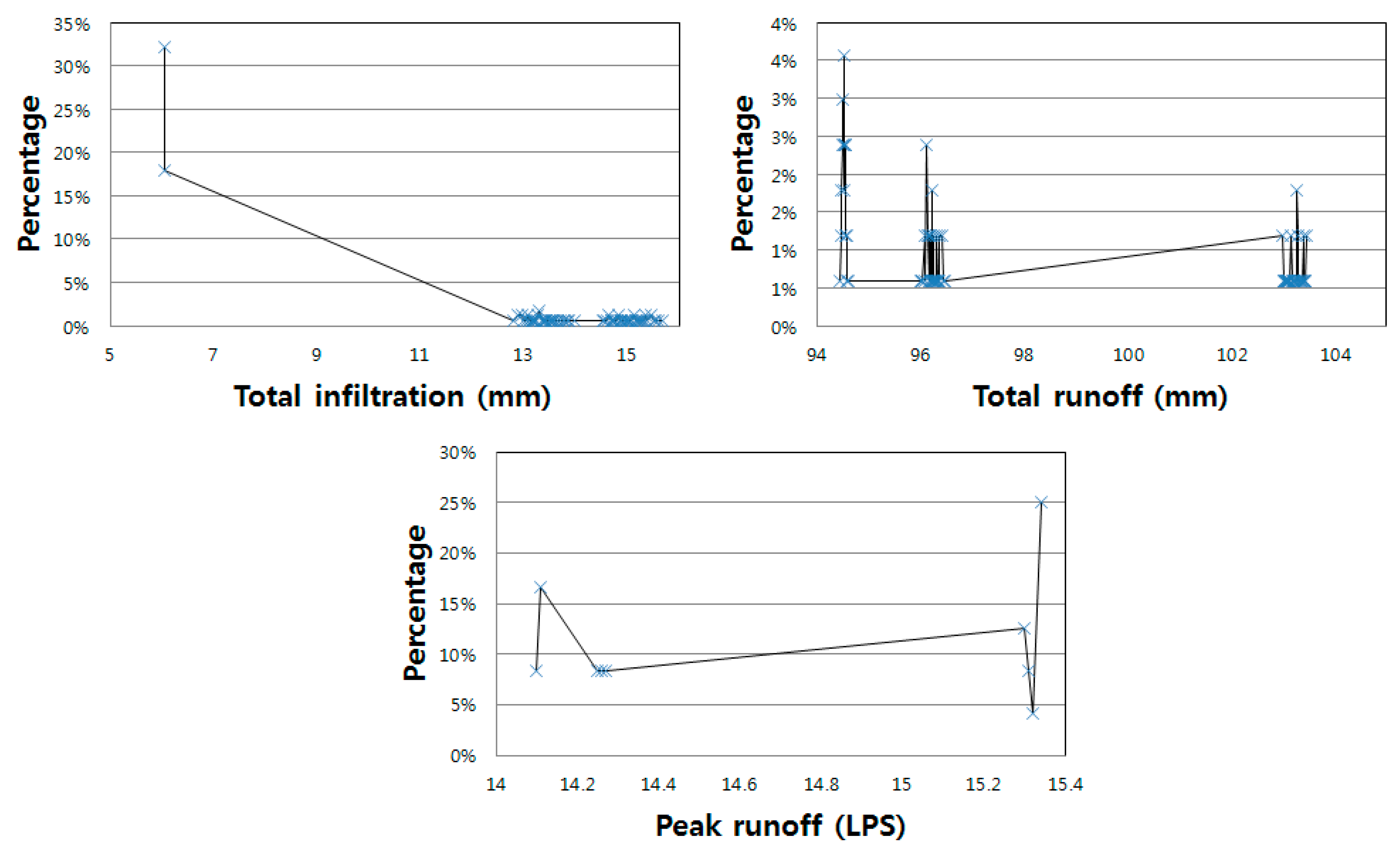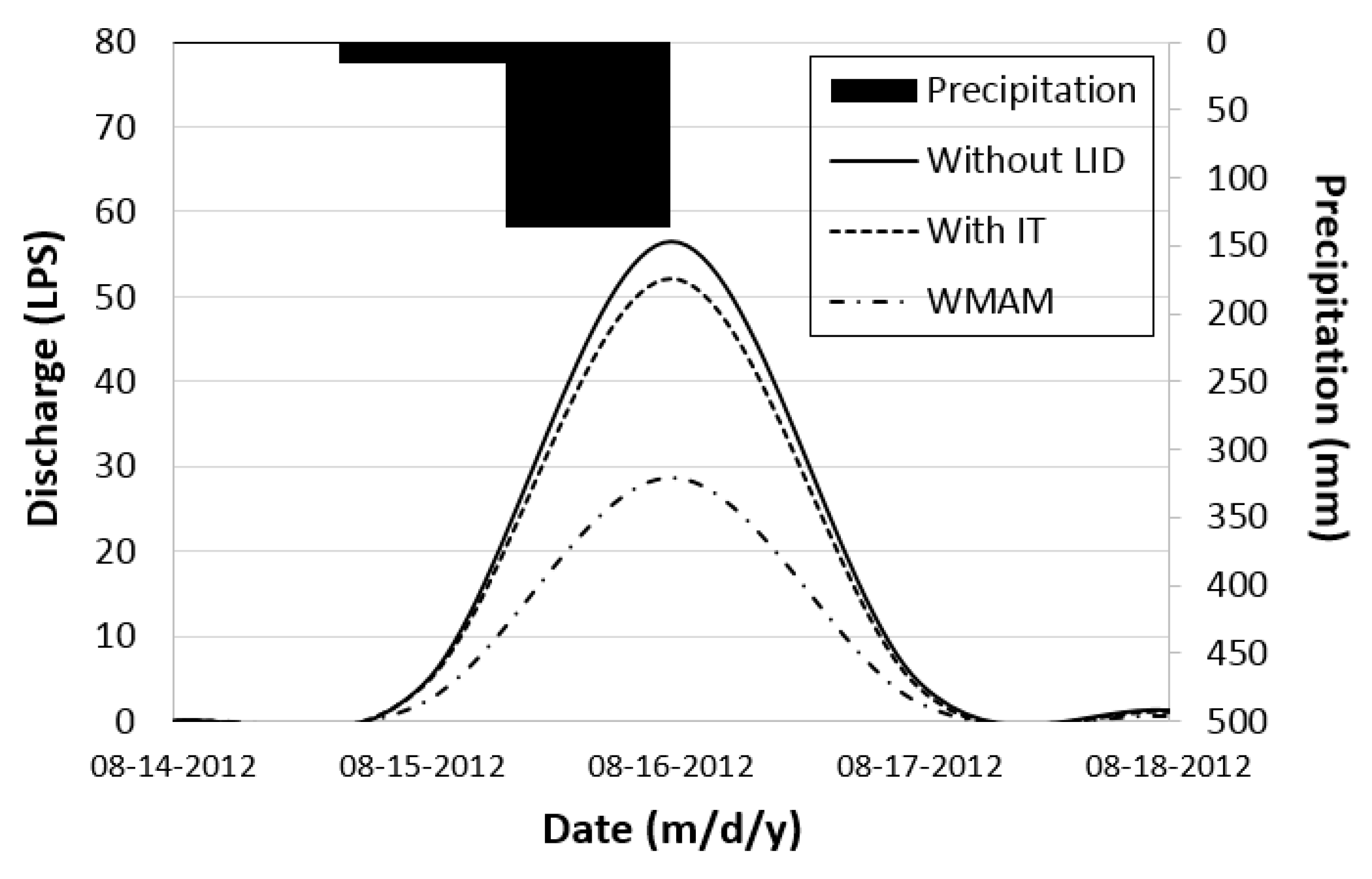1. Introduction
Over the past several decades, floods have become more prevalent and streamflow has been reduced or depleted due to increased runoff and higher peak flow caused by an increased impervious surface ratio. In addition, water quality within large urban streams has deteriorated dramatically. To prevent these negative impacts, implementation of low-impact development (LID) practices has become a popular way of mitigating against frequent natural disasters [
1]. Thus, LID practices have been proposed to maintain the pre-development hydrological features of urbanized districts, thereby mitigating the negative effects on receiving waters and watersheds [
2]. LID practices used at a catchment level have been demonstrated to significantly reduce runoff volumes, peak flows and mass exports of several pollutants in storm water relative to traditional development [
3,
4].
However, there has been great ambiguity in the determination of physical LID specifications that support efficient design and planning [
5], e.g., what values of specific LID components should be selected, or what sizes or numbers of LID practices should be used. Specific design and planning values for LID practices are difficult to achieve because different LID types and sizes can have similar effects on hydrological components [
6]. Thus, various studies to find the best solution for LID design and planning have been performed [
7,
8,
9,
10,
11,
12].
Several hydrological models that analyze LID practices have been developed [
13], including the best management-practice decision-support system (BMPDSS) [
14], BMPs SELECTion expert system [
15], rainfall–watershed bioretention (RWB) model [
16], diagnostic decision-support system [
17] and water-management prioritization module [
18]. However, very few hydrologic models can simulate LID performance. The storm-water management model (SWMM) developed by the Environmental Protection Agency (EPA) has been updated to assess the hydrological performance of various LID types and supports a function that compares simulation results before and after the installation of LID practices.
The PCSWMM, XPSWMM and others have been greatly improved based on the original SWMM concept and program. Although they have their own unique advantages, including the integration of GIS and 2D/3D hydraulic analyses, they are unable to inform the best physical specifications of LID design and planning for urbanized study regions. Although they support effective tools for simulating the hydrological effects of various LID types, they cannot simulate multiple scenarios for LID designs and planning parameters [
18]. Recent studies on LID applications incorporating the aforementioned decision-support systems (DSS) have been limited to applications for effectively mitigating flood risks and reducing runoff and pollutant levels in urban areas [
19,
20,
21].
This study developed a web-based DSS named the water-management analysis module (WMAM) to determine the best specifications for LID design and planning in any urban area. The WMAM was applied to a university campus in South Korea that has been heavily urbanized. A highly urbanized area of Seoul was selected as the study area.
3. Systematic Water-Management Analysis Module (WMAM) Procedure
The WMAM is a DSS used to identify the design and planning parameter specifications for LID practices and is based on the SWMM 5.1. There are six types of LID practices with between 5 and 23 design parameters each; the WMAM was developed to guide users through the automatic generation and simulation of the various LID design-parameter combinations. In addition, six LID practice planning parameters are included in the SWMM, resulting in many available combinations. A scenario analysis was conducted to estimate whether a case was good or bad and thus better define a given effect by comparing various cases. The analysis was designed to facilitate improved decision making by enabling outcomes and their implications to be considered. Six types of LID practices—bio-retention cells, rain gardens, green roofs, rain barrels, permeable pavement, and infiltration trenches—are available for use in the WMAM. The module’s primary function is to determine the most effective SWMM parameters for the design and planning of LID practices based on sensitivity and multi-scenario analyses of various hydrological components. Sensitive and effective parameters that critically influence total runoff, peak flows, infiltration and other factors can be identified through sensitivity analyses, and various cases can be simulated in detail through multi-scenario analyses.
The procedure developed in this study utilizes the SWMM to determine all effective design and planning parameters related to LID practices based on automatic SWMM simulation results [
10]. A flowchart of the WMAM and its details is presented in
Figure 2. The WMAM includes 10 steps divided into four systematic parts: (1) loading the SWMM file and selecting the target subcatchment and LID type; (2) sensitivity analysis of the LID design parameters; (3) multiple scenario analysis of the LID design parameters; and (4) multiple scenario analysis of the LID planning parameters. The WMAM ‘procedure’ describes the 10 steps that users should follow for the developed DSS; its ‘systematic algorithm’ describes the logic of how the WMAM functions to determine the best LID design and planning. The ‘details’ section in
Figure 2 describes the scenario generation and operation process based on the SWMM using the input information.
Part 1: For the WMAM, an SWMM input file, hereinafter referred to as SWMM_i, containing each LID practice should be constructed for the area of interest. Once the SWMM_i is loaded and the target subcatchment and LID types are selected in steps 1 and 2, respectively, SWMM_i is modified to another form. It excludes other information on LID types, except for the selected subcatchment and LID type.
Part 2: The WMAM automatically generates and simulates all SWMM input files corresponding to the values added in step 3, and a sensitivity analysis of the design parameters is conducted. In the third step, because the necessary parameters for all LID types differ, they automatically appear according to the selected LID type. To generate all possible scenarios for sensitivity analysis, minimum and maximum parameter values and the number of scenarios considered should be defined in this step. For example, if there are i design parameters related to the selected LID type and if the number used for the analysis of each design parameter is 11, the WMAM runs i × 11 times to simulate all cases. If there are different values for each parameter (j, k, l, and m), the total number of cases used in the SWMM simulation will be the sum of the given values (j + k + l + m). In the fourth step, the WMAM simulates all defined scenarios in step 3 with a single click and then analyzes all results. Hydrological results (e.g., total runoff, peak runoff, runoff coefficient, infiltration loss, surface outflow and final storage) are illustrated in graphs and tables. Users are able to know which design parameters influence the hydrological results most, and critical LID design parameters significantly affecting the hydrological components can be identified and screened by the user. In addition, any parameter showing no or slight effects on the important hydrological component can be removed from further analysis. This step can significantly reduce the number of all available scenarios that are not meaningful.
Part 3: The WMAM automatically generates various scenarios of the LID design parameters and simulates SWMM based on values entered in step 5. In the fifth step, the selected LID design parameters from the fourth step automatically appear, and users are then asked to re-enter all value ranges of the selected parameters. Target scenarios are defined in the same way as in the third step by entering minimum, maximum, and total numbers. However, this step considers all possible combined scenarios of design parameters. For example, assume that four design parameters are selected from the sensitivity analysis and that their quantities of plausible scenarios are q, r, s, and t. The WMAM will simulate the SWMM q × r × s × t times to analyze all possible combined cases of effective LID design. In the sixth step, the graph of relative frequency appears after many calculations, and users can then identify the distribution of hydrological performance. Additional simulations and calculations can be performed if users wish to find narrower value ranges for the design parameters. In the seventh step, users can recalculate all results for a specific hydrological component, and the top performance scenario can be identified.
Part 4: The WMAM automatically generates various scenarios of the LID planning parameters and runs the SWMM based on the values entered in step 9 and the scenario selected in step 8. In the eighth step, users must select the most effective scenario for LID design. Because some of the scenarios perform the same for all hydrological factors, users can choose any scenario based on other criteria, such as economic efficiency or social preferences. In the ninth step, users must enter all possible ranges of planning parameters to determine the parameters’ degrees of sensitivity to hydrological variables. Scenarios are defined as in step 5. All available combined scenarios of all planning parameters are included in this step. Because most planning parameters affect purchase and installation costs, proper numbers and sizes should be carefully determined. For example, assume that four planning parameters are selected as important criteria for LID planning and that their quantities of plausible scenarios are a, b, c, and d. The WMAM will perform the SWMM a × b × c × d times to analyze all possible combined cases of LID planning. In the tenth step, relative frequency graphs of the selected hydrological variables are presented. Users can thus choose the appropriate LID planning parameters based on their satisfactory performance. Of course, SWMM input and output files produced during this step can be downloaded for further analysis in the SWMM. The WMAM automatically generates various scenarios based on the values entered in step 9. In the end, one design and one planning parameter set will be derived from these four parts.
Thus, the WMAM can simulate numerous combinations of LID design and planning parameters and identify the most efficient scenario through a systematic process. Any step can be repeated to reduce the available value range. In future years, additional steps will be enhanced to determine the economic efficiencies of multiple LID planning scenarios based on cost-effectiveness ratios. In step 11, users enter approximate fixed and variable costs of feasible scenarios into hydrological criteria and the duration of the LID practice. The cost-effectiveness ratios for all hydrological components are then calculated. Finally, the proposed LID planning specification can be determined based on economic feasibility levels.
5. Conclusions
Many countries have suffered from floods, and the resulting damage has been tremendous. Therefore, LID practices have been considered to mitigate flood damages in urban areas. In addition, LID practices such as bio-retention cells, infiltration trenches, rain barrels, and pervious pavement have various positive functions, which include enhancement of water quality, aesthetic benefits, minor water supply, and groundwater recharge. Thus, in developed countries, the preference is to install LID practices when an area is being newly developed or re-developed. These practices can attenuate peak flows and increase lags in the timing of peaks which increase and decrease, respectively, due to urbanization. However, it is not easy to validate LID practices and find optimal hydrological design specifications.
The EPA’s SWMM and other extensions have been frequently used to simulate the hydrological function of LID practices. However, they cannot easily be used to identify the best LID design and planning specifications, as such extensions require the completion of numerous simulations and manual comparisons by changing all important parameters of LID design and planning to determine hydrological performance. The WMAM, a DSS based on the EPA’s SWMM 5.1 for LID design and planning, was developed in 2015 based on a 10-step systematic procedure and was applied to a real area to determine the most effective LID design and planning parameters. The WMAM offers a user-friendly web-based system that supports automatic scenario generation, SWMM simulation and results analysis. Specifically, the WMAM offers the following capabilities: (1) determining significant LID design parameters that critically influence the hydrological components of a study area via a simple sensitivity analysis; and (2) determining the best LID planning parameters for any hydrological aspect.
The case study shows that the WMAM supports a tool by which to determine effective LID design and planning parameters of various types by decreasing total and peak runoffs and by increasing infiltration. These results were compared with manually selected parameters. Finally, those superior scenarios with the best LID design and planning parameter values were identified by the WMAM, illustrating that the WMAM can be used in urban planning and urban-watershed management.
